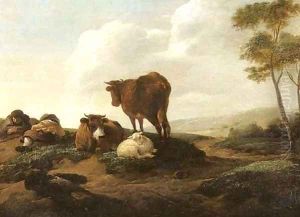Albert Jansz. Klomp Paintings
Albert Jansz. Klomp, also known as Albert Clomp, was a Dutch Golden Age landscape painter whose birth year is somewhat uncertain but is often cited as either 1616 or 1620. Not much is known about his early life, including the exact date and place of his birth, which is a common issue for many artists of the period due to poor archival preservation or incomplete records. Klomp's work primarily consisted of pastoral scenes, often featuring cattle, which was a popular subject matter of the time, indicative of the Dutch pride in their agricultural and pastoral accomplishments.
During his career, Klomp was active in Utrecht, where he likely received his artistic training and was influenced by the works of Paulus Potter and the Utrecht Caravaggisti, a group of Utrecht artists who were influenced by the style of the Italian painter Caravaggio. However, Klomp's own style was distinct, characterized by a somewhat looser brushwork and a preference for idyllic country life scenes, sometimes incorporating elements of Italianate landscape painting, which was also fashionable among Dutch painters of his era.
Klomp's paintings were well-received, and he was able to make a living as an artist, which was a significant achievement at a time when the art market could be capricious. His works are now held in various art collections and museums, and while he may not be as well-known as some of his contemporaries, his contributions to Dutch landscape painting are appreciated by art historians and collectors.
The records of Klomp's later life and the circumstances of his death are also unclear. Some sources suggest he died in 1688, while others speculate he may have lived beyond that year. Despite the lack of comprehensive biographical details, Albert Jansz. Klomp remains a figure of interest for those studying the Dutch Golden Age, and his pastoral landscapes continue to evoke the serenity and prosperity of the Netherlands during the 17th century.
